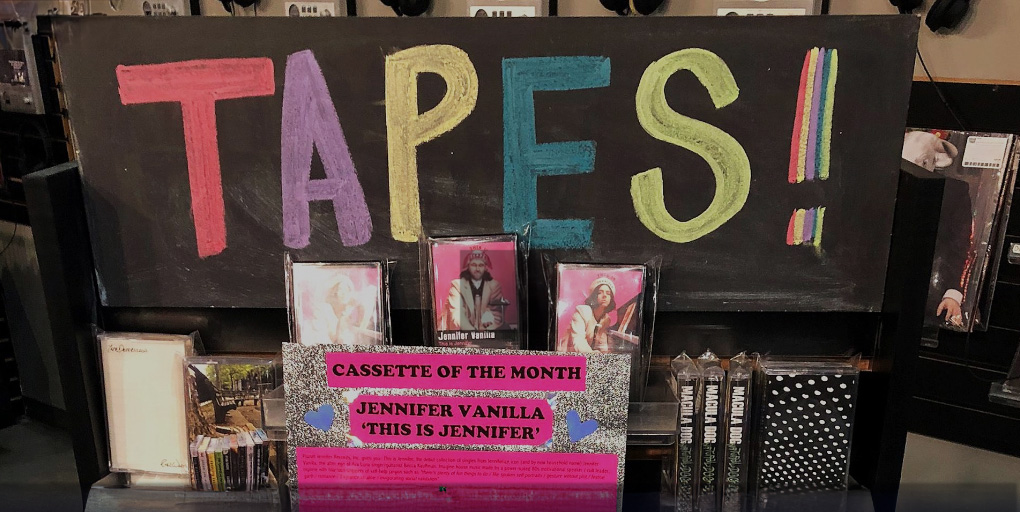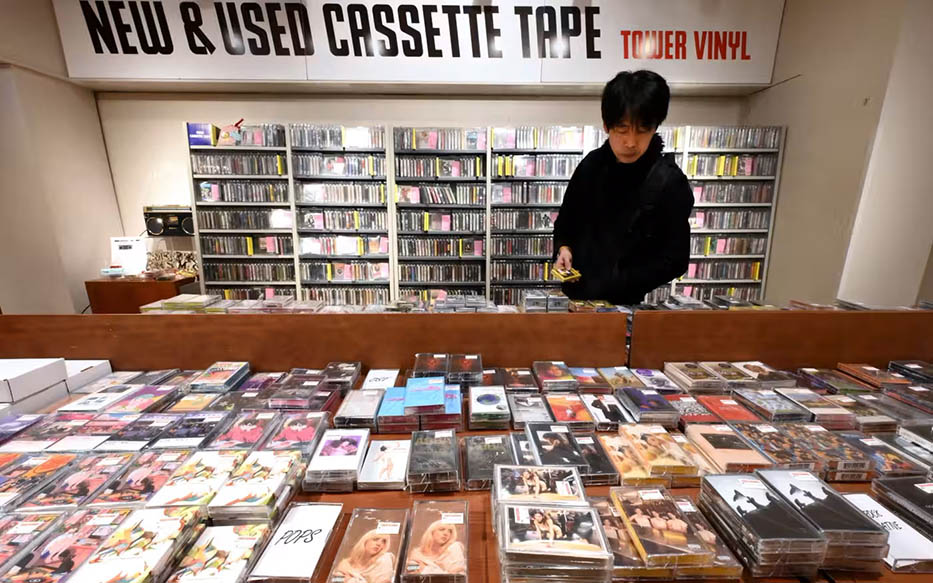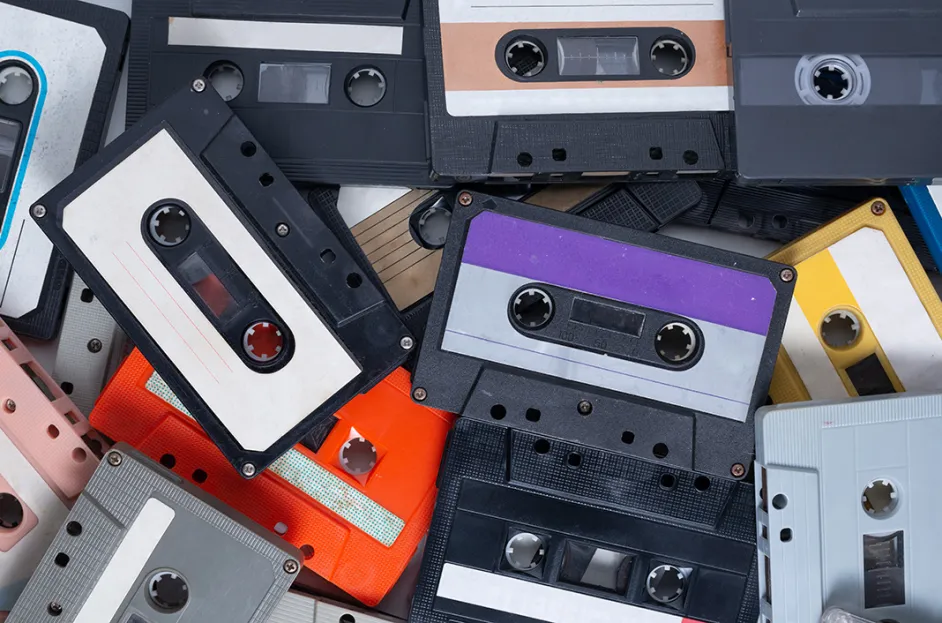
The Nikkei is reporting a robust revival in Japan of sales of prerecorded analog cassette tapes, a format once thought dead and gone. Now, the report says, the humble cassette tape “is experiencing a renaissance, charming a new generation of music enthusiasts with its nostalgic appearance and distinctly warm and rich sound.”
First vinyl and now cassettes, what’s going on?
The humble cassette tape is growing in popularity in Japan, so much so that music stores are opening up whole departments dedicated to the analog category. In fact, there are even specialty stores that are completely dedicated to carrying nothing but prerecorded cassette tapes for sale – both new and used.
I have previously reported on the continued growth of vinyl albums here in the states, which are enjoying the same kind of popular resurgence. At first, it seemed like this return to analog might just be some kind of fad. But now, more than a decade later, it is clear that vinyl has a large number of enthusiasts supporting the category.
Young Enthusiasts in Japan are Powering a Rebound in Cassette Sales
Upon learning of the statistical data, the Nikkei deployed reporters around Tokyo to investigate these cassette tape-dedicated departments and speak with users to try and understand the appeal. What’s interesting is that many of the user comments from cassette tape enthusiasts remind me very much of how vinyl fans describe what attracts them to that format as well.
The data in Japan shows that sales of both new and used cassettes are growing in popularity. A visit to a Tower Records store in Tokyo revealed that the popularity is particularly strong with the younger enthusiasts in their 20s or 30s, according to the staff there.
“A cassette tape is for when I want to listen to music carefully,” a male 21-year-old university student at a Tokyo Tower Records told the reporter. He noted that he also streams music, but he has begun to collect cassettes which he reserves for more serious listening sessions as he prefers their “warm, unique sound.”

For the Younger Generation, Cassettes are Different and New
It’s interesting to note that this younger generation that appears to be most interested in cassettes never experienced them back in their peak times in the 1980s. In fact, these young enthusiasts didn’t even exist then. So for them, it is a bit of a curiosity, something different and new.
The report notes that the Tower Records Shibuya store has expanded its assortment of new and used cassettes to more than 3,000 titles to take advantage of the market growth. The report notes that this is six times the number they had been stocking up to now.
Tower Records Manager: Cassettes Attract Younger Listeners and Foreign Tourists
The head of the cassette department at Tower Records, Ko Takeda, said, “The age of purchasers varies from teenagers to people in their 50s, with 30-somethings forming the biggest group. Cassettes seem to come across to the younger generation as ‘new and cute’ things.”
The cassette selection also seems to attract quite a few foreign tourists, the department head added.
Tower Records has also seen strong growth in the sales of vinyl records as well. However, Takeda added that cassettes are a less expensive analog format – which may be another reason why the younger crowd likes them. The typical cassette sells for about ¥1,000 (about $6.65) which is well under the cost of a typical vinyl LP.

‘Waltz’, A Cassette-Only Store, Says Modern Artists are Helping Drive Interest in the Format
Also in Tokyo is a store called “Waltz,” which is a specialty store that only sells cassette tapes. This kind of blows my mind because, like New York City, commercial real estate in Tokyo is incredibly expensive. But Waltz, which started by offering only used cassettes, now offers both used and new titles.
Taro Tsunoda, who runs Waltz, notes, “Major artists are also paying attention to the trend, and the value of cassettes in the music market is rising.” He adds the business environment surrounding cassettes has “drastically changed from how it used to be when we opened.”
Manufacturers are Cranking Up Cassette Player Production
Tsunoda believes that there is more behind the appeal of cassettes. “Cassettes are something you can own and feel attached to. For the younger generation, they are novel, and for those who used them before, they evoke nostalgia about their early days of listening to music.”
Predictably, the popularity of cassettes has created a market for players. And companies have risen to serve the market. Toshiba Lifestyle based in Kawasaki has rolled out a new portable cassette player modeled on those from the 1980s, but updated with, for example, wireless earbuds which fits in better with today’s consumer lifestyle. They call their player “Walky” a clear nod to the first such players from Sony back in the day known as a Walkman.
Manufacturer: Cassettes are ‘Tangible Items to Own and Cherish’
Another manufacturer called “Side-B Creations” also offers cassette players (and tapes). Takamasa Endo, President of Side-B Creations tells the Nikkei that over the last 7 years, sales have grown 10-fold.
“For consumers, cassette tapes offer tangible items to own and cherish,” Endo said.
This resurgence of the generations-old technology is even entering the pop culture in Japan. Top fashion brands are said to be handing out cassettes as either invitations to fashion shows, or keepsakes with the music used during the fashion show as something to remember the event by. This is increasingly seen as hip or savvy by the high fashion community.
But What About Here in the U.S.?
You may be surprised to learn that even here in the U.S. there are signs of a resurgence of cassettes. According to Billboard, an entertainment industry media site, in 2022 sales of cassette tapes increased 28% to 440,000 units, as compared to 343,000 units sold in 2021. While this is small in comparison to overall music and album sales, it is strong growth for a category that has been growing for several years now.
In 2015, sales of cassettes were just 74,000 units. That means that the product category grew by 495% in the seven years from 2015 to 2022. With 7-years of strong growth under its belt, I’d say cassette tapes may not have yet stimulated the mania here they are having in Japan…but it is beyond a short-term fad here, as well.
One final note about the cassette comeback – while you and I may not have noticed it happening, many professional artists have. Major music stars like Taylor Swift, Harry Styles, and Billie Eilish now routinely release all of their latest material on multiple formats, including physical ones like vinyl LPs, CDs, and cassette tapes.
Sometimes…what’s old is new again…





Great story Ted – my phone is constantly being inundated with “cassette revival” stories (of course I am constantly looking!). Here at Inner Sound in Portland, Oregon we stock 10-20 fully refurbished cassette decks on any given day. From basic, entry-level Sony / Kenwood / JVC decks to higher-end Aiwa / Nakamichi / Yamaha models. Having never moved away from cassettes, I’m “one of those guys” that is feeding the comeback.
Mike,
You’re a trend setter! Thanks for sharing your thoughts.
Ted
It cant be the sound quality, cassettes are lossy, nowhere near equal to the original master recording, our holy grail of high fidelity. Today’s hi res audio content meets that definition. No loss.
It must be their Vintage connection, nostalgia drives the vinyl market too. And its “tangible”, physical media in a world of digital streaming where the consumer never comes in direct contact with the content.
Like all fads, it will come and go, just like it did originally.
Every medium has advantages and disadvantages. I have a large collection of half-speed mastered and foreign-pressed records, which reduced the hiss and clicks and pops. My cd collection includes many albums (Beatles, etc.) that are too brassy, but eliminate the noise. My extensive cassette collection includes countless live radio recordings that were made on a quality deck (plus 10 band equalizer), as well as many themed tapes made from cds. Back in the 1980s and 1990s, I invested in the best quality CRO2 cassette tapes (including some ferrichrome) made by Maxell, TDK, Sony and BASF.. I’m happy to say that the quality of these recordings has held up for 35-40 years! In the last 2-3 years I was fortunate to buy on eBay several Toshiba, Panasonic, Sony and Sharp cassette players from 1985-1988 that have either 5 or3 band equalizers! I found someone who knows how to repair them and set the proper speed. Now, I plug in my quad earbuds and have a marvelous time during hikes; I also play my cassettes on a nice stereo on my deck. The sound is still great, with excellent aural placement. And, I love fine-tuning the sound with my eq!!
Maybe it’s experiencing a comeback but the last data I read from RIAA reflects cassette sales only being 0.04% of total prerecorded music sales.
Yes, it’s true that all the analog categories are smaller than digital streaming and I certainly didn’t mean to suggest otherwise. But Cassette is seeing a strong growth rate and if that continues over the coming years (as vinyl has) those numbers could become more significant.
I find the trend curious…
Ted
As my shop repairs anywhere from 5 to 20 cassette decks each month, virtually no customers mention wanting to buy / use “new” tapes. I had no idea that big-label artists were even releasing material on cassette. The sentiment here is generally playing back tapes they already have (or recently acquired) and sometimes for “new” recordings they make themselves.
The “vintage” connection mentioned above is likely in play, but the more intangible connection (and having a stronger bond) is simply our “memories”. While I couldn’t afford the best audio gear as I began my time in the HiFi trenches, I had access to great gear / new vinyl / good blank tapes / nice tape decks. Many of the tapes I have (made in the late 80’s) still sound great (perfect? No, but who would claim that?), and many of my current recordings sound great as well.
More importantly – those little plastic boxes evoke my past life in ways that “todays hi res audio” will never have a chance to! The amount of time spent creating labels for mix tapes are the poetry of my life, and someone who doesn’t “get it” likely never will – and that’s ok! Try tying your first child (or first wife) to a hi res playback list :) Even the connection to vinyl is devoid of any deep personal / specific effort – the basis for creating memories. (well, maybe some folks did pour their hearts and souls into musings on LP jackets).
The idea that cassette tapes are “nowhere near equal to the original master recording” is missing the point, and that’s ok too – it certainly isn’t hindering the current trend. Seriously – I can’t open a HiFi mag without reading about how this-or-that newfangled component / source “is nowhere near equal to the original master recording”, or tries to be – if only we spring for another subscription.
I guess some of us are stuck between the grooves – always searching for the “absolute sound” and yet content with something we already have that might not be perfect – yet brings a smile to our collective faces. Heck, I show ANYONE my various collection of streamers / DACs / libraries etc. it’s like looking at tax tables. Show them my Nak CR7 in action? Plenty of smiles! Then they’re blown away that the material actually sounds great.
Cheers.
Thanks for your thoughts, Mike.
Ted
Color me pessimistic but maybe all these people are only seeing the romantic side to this whole cassette tape craze (love mix tape and all). They aren’t thinking of all the times they had to respool a cassette because their tape deck ate it. Or having to rewind a cassette tape manually because that function stopped working on their tape deck. Or just the flat out low fidelity that the cassette has to offer. And all this is coming from a born and raised Gen Xer. You guys can keep the cassette. I’m never going back.
Cassette sales represents 0.04% of prerecorded music. For discussion purposes, let’s say it grew from 0.03%. As a percentage, that’s significant but in actual numbers it’s not even a blip on the radar. Trend or just a nostalgic story?